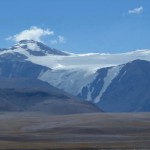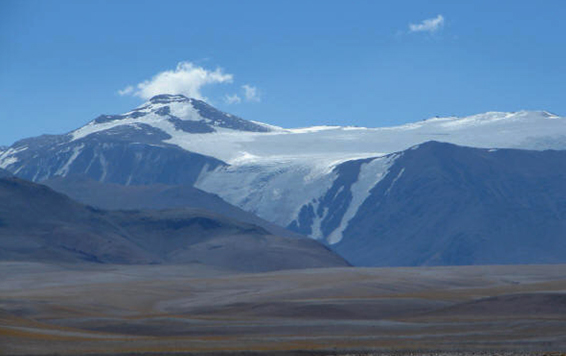Esta entrada también está disponible en: Spanish
 April 9, 2012- La Rioja Argentina. A report published today in Argentina reveals that exploration projects underway in Argentina’s La Rioja Province, including Cerro Verde (Anglo American), Caballos (Golden Arrow), Sillimanita-El Potro (NGEx Resources, previously Suramina) and Famatina (Osisko), do not have environmental impact studies for exploratory phases to address their impacts or potential impacts on glaciers and permafrost zones. If impacts are verified or if any risks to glaciers are confirmed, any mining activity at these projects sights would be illegal under Argentine law, without proper glacier studies and authorization by provincial and national authorities.
April 9, 2012- La Rioja Argentina. A report published today in Argentina reveals that exploration projects underway in Argentina’s La Rioja Province, including Cerro Verde (Anglo American), Caballos (Golden Arrow), Sillimanita-El Potro (NGEx Resources, previously Suramina) and Famatina (Osisko), do not have environmental impact studies for exploratory phases to address their impacts or potential impacts on glaciers and permafrost zones. If impacts are verified or if any risks to glaciers are confirmed, any mining activity at these projects sights would be illegal under Argentine law, without proper glacier studies and authorization by provincial and national authorities.
This new information of yet another province where mining is in conflict with glaciers, adds further controversy to the predicament faced today by mining exploration projects underway in much of the Andes region of Argentina and Chile. A recent national glacier protection act has declared mining operations illegal in glacier zones. This has sent companies like Barrick Gold (Pascua Lama and Veladero) and Xstrata Copper scrambling to build legal attacks against the national law.
Provincial laws also protecting glaciers which appeared concurrently to the national act, further emphasize the “no-go” reality for several mining projects. Xstrata Copper’s El Pachón project, for instance, includes by the company’s own estimates, more than 200 glaciers in the concession area, several of which are to be totally destroyed by the project’s pit excavation and waste pile site choices. Twenty to thirty percent of the project’s area is also permafrost (frozen ground) which is also protected by law. Xstrata has an international case filed against El Pachón in Australia and Argentina, which is pending review by national authorities.
“It’s no wonder these mining companies are attacking the glacier protection laws. They know their projects are very exposed and at stake. If the law is upheld (which we hope it is) these projects will have to close up shop and go home”, says Jorge Daniel Taillant, author of the “Mining and Glaciers in La Rioja Province” report (only available in Spanish).
Taillant founded and directs the Argentine non-profit group, Center for Human Rights and Environment (CEDHA). Concerned with the lag in government authorities and agencies which should be forcing the implementation of the glacier law, he’s published several similar reports as a “Mining and Glaciers series”, which focuses precisely on mining influence on glaciers in the region. CEDHA has already published similar reports on El Pachón (Xstrata Copper), Filo Colorado (Xstrata Copper), Agua Rica (Yamana Gold, soon to be Xstrata), and a preliminary survey on the Del Carmen project (Malbex). Other reports are expected soon on Los Azules (Minera Andes, now McEwen Mining), Pascua Lama (Barrick Gold), and El Altar (Peregrine Metals), all in glacier areas.
CEDHA’s report on La Rioja reveals more than 400 glaciers and other protected ice bodies in provincial territory, many of which are in mining areas. The report also maps over 40 mining projects underway in the province which the local authority will not reveal, despite recent rhetoric by provincial and national mining authorities suggesting they want to “educate” the public on the benefits of mining.
The national government recently announced the creation of the OFEMI, an agency with provincial contribution who’s single objective is harmonizing national and local media to promote more social acceptance of mining in the region. This initiative comes on the heels of mounting tensions in local communities such as Famatina and Chilecito, both in La Rioja province, which have mobilized by the thousands impeding the advancement of the Famatina project (Osisko). Similar local protests exist in neighboring Catamarca province regarding Agua Rica (Yamana, and now Xstrata) which is also paralyzed due to community opposition and a court order forbidding advancements on the project.
CEDHA has utilized publicly available images from Google Earth to carry out a glacier inventory, and in one month, created a preliminary glacier inventory for La Rioja province which would otherwise not have been available for another four years as programmed by the national glacier inventory initiative, deriving from the National Glacier Act. The interesting thing about the inventory and for local communities which fear the potential impacts of mining and don’t believe local authorities (which have denied the presence of glaciers around projects such as Osisko’s Famatina) is that the inventory can be easily downloaded and immediately viewed in Google Earth. The link in this paragraph downloads a KMZ file which can be unzipped and opened in Google Earth.
The report reveals images already visible showing mining impacts to glaciers along the Chilean border, and even the full concession of the province’s largest glacier, El Potro (the glacier in the image above) to the Canadian company, Suramina (now NGEx Resources). CEDHA has obtained documentation from the company showing the mining concession with clear indication that the concession is actually of the ice cover!
The Famatina concession (Osisko) is no better and includes over 30 glaciers in the project area, all to be affected if the project is to move forward.
Provincial and national authorities are not moving quickly enough, says CEDHA, to implement the national glacier act or for that matter, the provincial laws that are the first in the world to protect glaciers, a natural resource at risk due to global warming and now to anthropogenic impacts caused by mining.
Links to the report
Full Report in Spanish Only
https://center-hre.org/wp-content/uploads/Glaciares-y-Miner%C3%ADa-en-la-Provincia-de-la-Rioja.pdf;
Executive Summary in English:
https://center-hre.org/wp-content/uploads/Glaciares-y-Miner%C3%ADa-en-la-Provincia-de-la-Rioja-English-Summary-1.pdf
For more information about this report, contact the author at:
Jorge Daniel Taillant
tel. +54 9 351 507 8376

